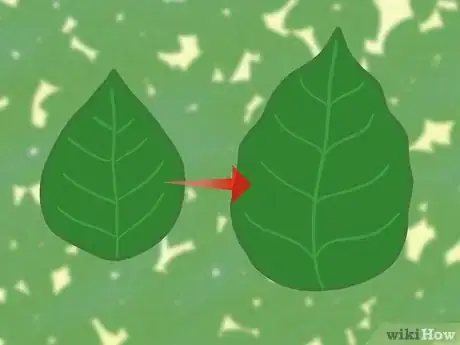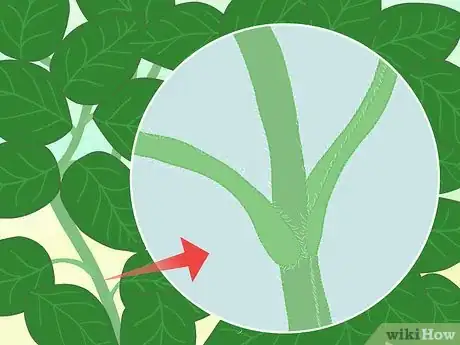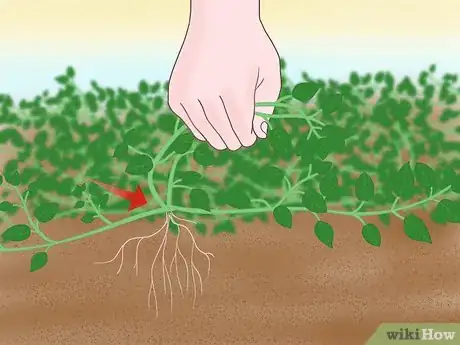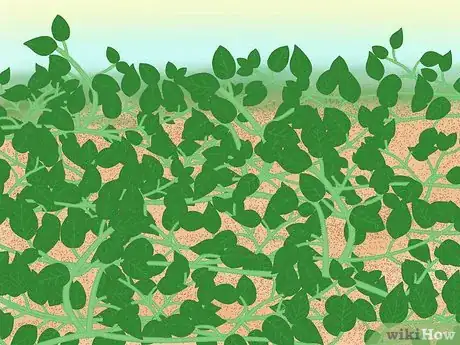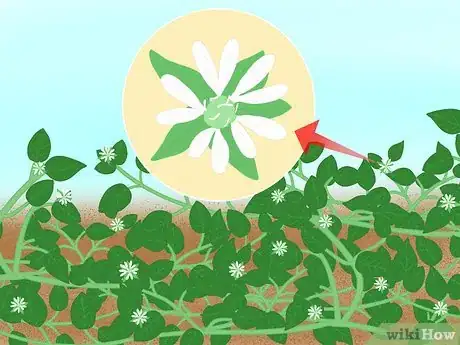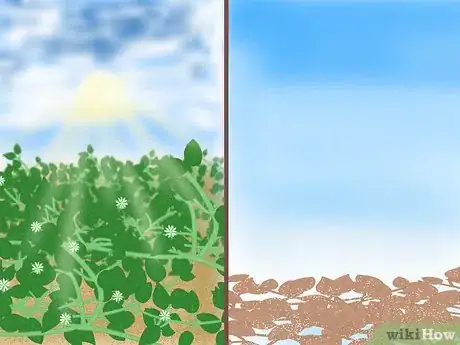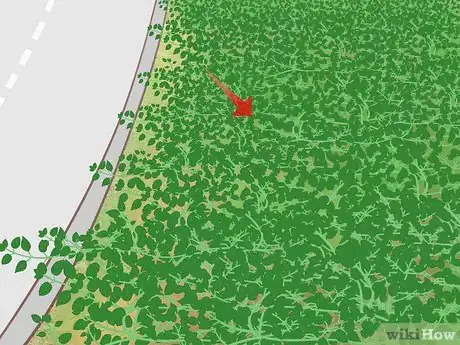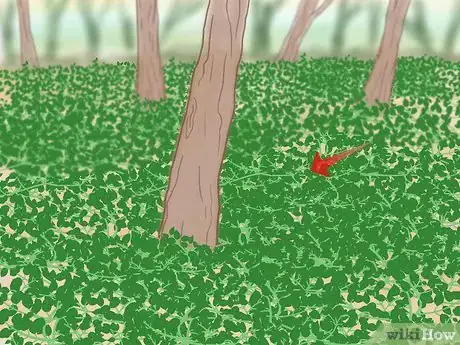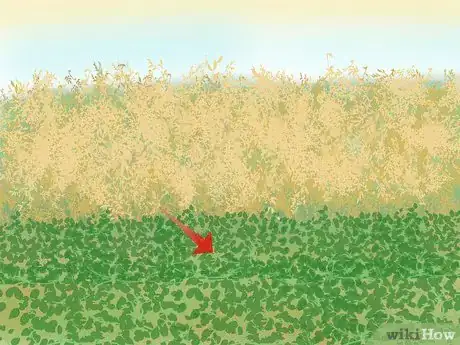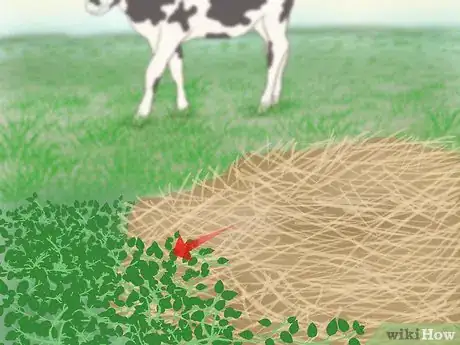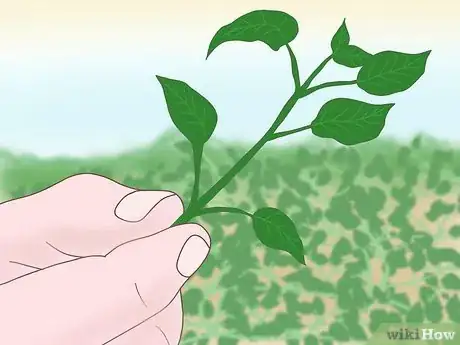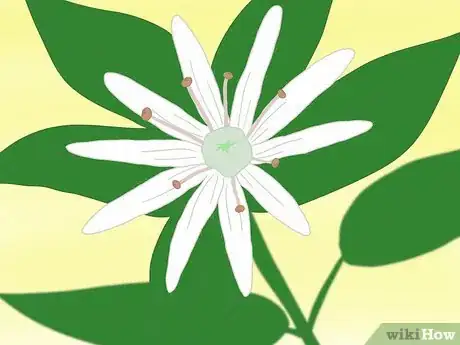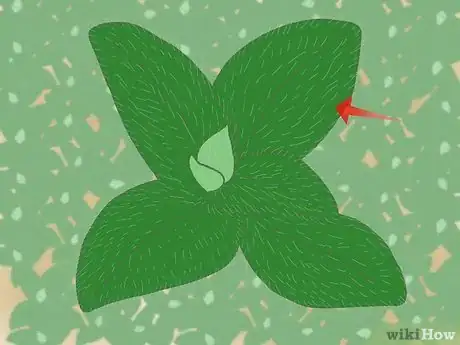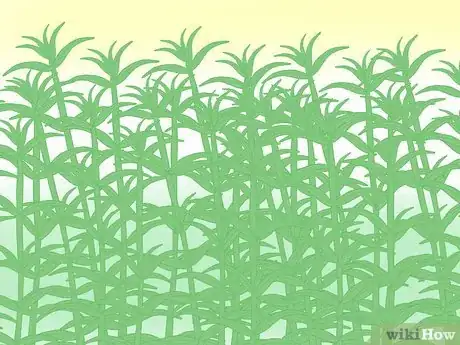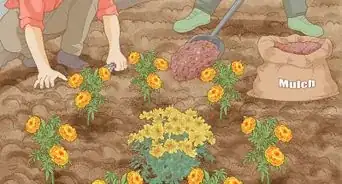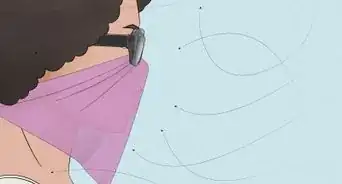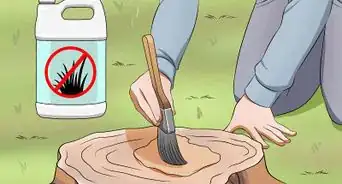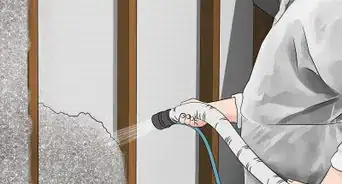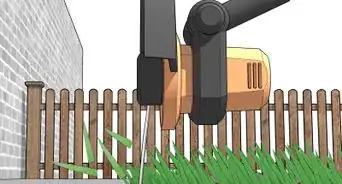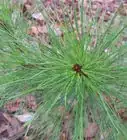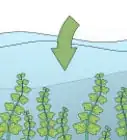This article was co-authored by Lauren Kurtz. Lauren Kurtz is a Naturalist and Horticultural Specialist. Lauren has worked for Aurora, Colorado managing the Water-Wise Garden at Aurora Municipal Center for the Water Conservation Department. She earned a BA in Environmental and Sustainability Studies from Western Michigan University in 2014.
wikiHow marks an article as reader-approved once it receives enough positive feedback. This article received 12 testimonials and 89% of readers who voted found it helpful, earning it our reader-approved status.
This article has been viewed 115,802 times.
Chickweed is a common edible weed that contains plenty of nutrients. It's often found growing along the roadside or winding its way through urban and farm environments alike. If you're interested in adding it to your salad bowl or throwing it in your soup, it's important to know how to identify it.
Steps
Identifying the Physical Features of Common Chickweed
-
1Identify the leaves. The leaves for common chickweed (also known as stellaria media) begin as small ovals with a pointed tip. As the plant matures, the leaves grow larger and begin to ruffle slightly. The ruffles form around the edge of the oval and looks like a different shape.
-
2Examine the stem. One characteristic detail of the chickweed’s stem is the direction of the hair. If you examine the stalk’s hair, you’ll notice that the hairs change position at each node. The node is the knot-like location where the leaves extend out of the stalk.[1]Advertisement
-
3Reveal the inner core. Another characteristic feature of the common chickweed is the inner-core, underneath the stalk. You can reveal the inner-core by pulling the stem of the plant. The inner-core happens because plant develops multiple stalks from the same root system.[2] This is also the reason that a mature plant will sprawl.
-
4Look for a sprawling plant. Chickweed grows in a sprawling fashion. It has a weak stem and each side of the stem has a single line of hairs. Younger plants won’t sprawl quite as fully as a matured plant. Instead of looking for a tall plant, seek out a flat sprawling plant.
- Since there are so many stalks coming from the root system, many weaker plants will become engulfed by chickweed. This is the reason why many lawn owners dislike chickweed.
-
5Identify the small white flowers. These appear in the spring and summer time. Each flower has five petals and the deep notching on the flowers makes it appear like 10 petals.
Finding Common Chickweed in its Natural Habitat
-
1Know chickweed’s climate. Common chickweed is found throughout the world, and has been reported in every American state. The plant is an annual, meaning it blooms in the spring and dies in the winter. Common chickweed has a high resilience to cold weather, and sometimes will last through a mild winter.
- Since it is so common and strong of a plant, it can be found in almost every climate.
-
2Look for chickweed’s common areas. Look for it where it grows. Common places include the roadside, gardens, vacant lots, and grasslands. It is one of the most common weeds found in lawns.
-
3Identify areas prone to flooding. Common chickweed prefers low-leveled areas that accumulates water easily. You're even more likely to find common chickweed in a wooded area that's prone to flooding. Check around your house or neighborhood for low leveled areas that fit this description.
-
4Check lawns or croplands. Common chickweed is an invasive species that prefers areas with a history of disturbance, similar to poison ivy.[3] Areas with a history of disturbance include places where the natural ecology has been disturbed like: farming areas, lawns, trails, or fielded areas.
-
5Seek common chickweed in other areas. Common chickweed prospers in nutrient-rich areas that may be disturbed or receives plenty of water. Other areas that chickweed is commonly spotted is on walls, new plantations, sewage plants, and near animal manure.[4]
- It has also been reported along coastal strand-lines of beeches and lakes.
-
6Harvest the chickweed. The entire plant is edible and can be used in salads or cooked with other meals. The top of the plant is the best, as the base is woody or stringy. There are also topical benefits from the plant, such as helping a rash.[5]
- Crush up the plant and rub onto areas of your skin, such as a rash or breakout. If you are experiencing an allergic reaction, chickweed won’t substitute proper medical support.
Classifying Other Chickweeds
-
1Identify star chickweed. Star chickweed, or stellaria pubera, is a less known variant of chickweed that is mostly found on the east coast. The flowers are twice as large as common chickweed. Furthermore, star chickweed doesn’t sprawl as heavily as common chickweed. One distinguishing feature of the star chickweed is that its hairs extend onto the flower section.
- The stalk of star chickweed is stronger than the common chickweed, but it is still possible to expose the inner-core.[6]
-
2Find mouse-ear chickweed. Mouse-ear chickweed, cerastium vulgatum, is another variety of chickweed that has distinguished dark green leaves. Mouse-ear chickweed is a perennial weed, meaning it lies dormant through the winter and blooms in the spring. This weed also has more hairs that cover the leaves instead of a single line of hairs.
- The name “mouse ear,” is derived from the fuzzy leaves resembling little mouse ears.
- You aren’t supposed to eat mouse-ear raw, and instead should cook it like you might cook matured spinach.
-
3Identify field chickweed. Field chickweed, or cerastium arvense, is a native North American plant that’s more of a flower than a weed. The leaves are dark green like mouse-ear chickweed, but are shaped more narrowly than other chickweeds. Mouse-ear grows more commonly as an invasive species.[7]
- The flowers of field chickweed are almost identical to the other types of chickweed.
- The field chickweed doesn’t take over other plants.
Expert Q&A
-
QuestionCan you eat chickweed raw?
 Maggie MoranMaggie Moran is a Professional Gardener in Pennsylvania.
Maggie MoranMaggie Moran is a Professional Gardener in Pennsylvania.
Home & Garden Specialist Yes, some chickweed can be eaten raw, although Mouse-ear Chickweed does need to be cooked.
Yes, some chickweed can be eaten raw, although Mouse-ear Chickweed does need to be cooked. -
QuestionWhat is chickweed and how do you use it?
 Maggie MoranMaggie Moran is a Professional Gardener in Pennsylvania.
Maggie MoranMaggie Moran is a Professional Gardener in Pennsylvania.
Home & Garden Specialist It is a type of plant in which the leaves can be used for medicine. They help with constipation, stomach and bowel problems, and blood disorders, among other things.
It is a type of plant in which the leaves can be used for medicine. They help with constipation, stomach and bowel problems, and blood disorders, among other things. -
QuestionWhat are the benefits of taking chickweed?
 Maggie MoranMaggie Moran is a Professional Gardener in Pennsylvania.
Maggie MoranMaggie Moran is a Professional Gardener in Pennsylvania.
Home & Garden Specialist There are a lot of reasons people take chickweed such as for constipation and other stomach or bowel problems. Chickweed can also help with blood issues, lung disease, and even obesity.
There are a lot of reasons people take chickweed such as for constipation and other stomach or bowel problems. Chickweed can also help with blood issues, lung disease, and even obesity.
References
- ↑ http://identifythatplant.com/stellaria-chickweed-species/
- ↑ http://identifythatplant.com/stellaria-chickweed-species/
- ↑ http://www.illinoiswildflowers.info/weeds/plants/cm_chickweed.htm
- ↑ http://www.illinoiswildflowers.info/weeds/plants/cm_chickweed.htm
- ↑ http://www.eattheweeds.com/chickweed-connoisseurs-2/
- ↑ http://identifythatplant.com/stellaria-chickweed-species/
- ↑ http://oregonstate.edu/dept/nursery-weeds/weedspeciespage/mouseear_chickweed/field_chickweed_vs_mouseear.html
About This Article
To identify chickweed, start by looking at the plant's leaves, which will look like an oval with a pointed tip if it's chickweed. Also, take a look at the little hairs growing on the stem. If they change direction at each node, which is a spot where a leaf is growing out of the stem, it could mean you're looking at chickweed. Also, check the ground to see if the plant is flat and sprawling since that's how chickweed grows. If it's spring or summer and there are small white flowers on the plant, you might be dealing with chickweed. To learn how to find chickweed in its natural habitat, scroll down!
